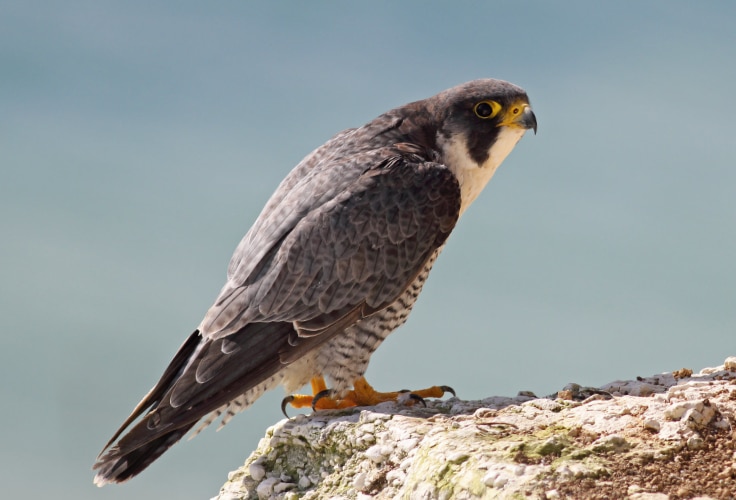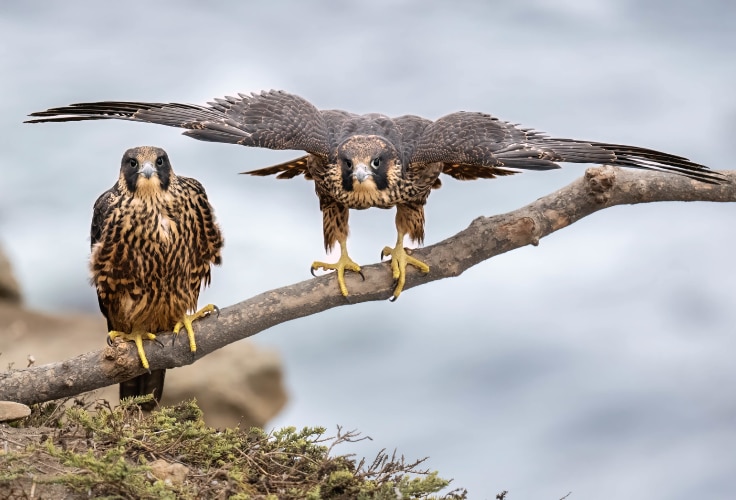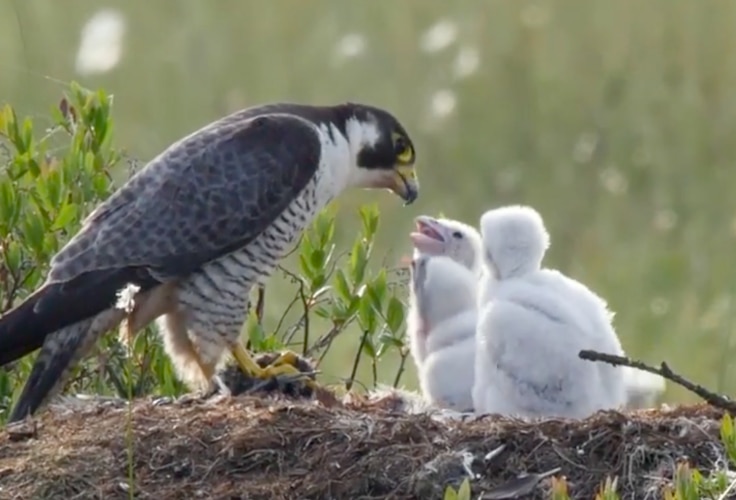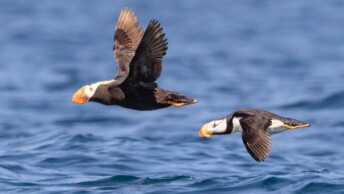The peregrine falcon (Falco peregrinus) is one of the most widespread and iconic birds of prey, known for its unmatched aerial speed, adaptability, and long association with human culture. Found on every continent except Antarctica, this powerful raptor inhabits environments ranging from Arctic tundra to tropical coastlines and urban skyscrapers.
Once driven to the brink of extinction in parts of its range due to pesticide contamination, the peregrine has become a symbol of successful conservation, recovering through decades of intensive effort. Its global presence, ecological versatility, and striking appearance make it one of the most studied and admired falcons in the world.

| Common name | Peregrine falcon |
| Scientific name | Falco peregrinus |
| Alternative names | Peregrine; historically duck hawk and black-cheeked falcon |
| Order | Falconiformes |
| Family | Falconidae |
| Genus | Falco |
| Discovery | First described in 1771 by M. Tunstall |
| Identification | Medium-to-large falcon with long pointed wings and strong build; adults slate-gray above with barred underparts and black facial marking |
| Range | Cosmopolitan distribution across all continents except Antarctica; breeds from Arctic tundra to tropical islands |
| Migration | Highly variable; Arctic and northern breeders are long-distance migrants; many temperate and southern populations are resident or partially migratory |
| Habitat | Wide range of habitats including tundra, deserts, wetlands, mountains, and cities; nests on cliffs, tall trees, buildings, and other high structures |
| Behavior | Solitary or in pairs; highly territorial during breeding; known for high-speed stoops during hunting; juveniles play extensively to develop flight skills |
| Lifespan | Typically 6-10 years in the wild; maximum recorded age in the wild is at least 21 years; up to 25 years in captivity |
| Diet | Primarily birds (over 75% of diet); also bats, rodents, and occasionally fish or insects |
| Conservation | Least Concern (IUCN); populations stable or increasing following global recovery efforts |
Discovery
Long before formal scientific recognition, falcons resembling the peregrine were known and admired across cultures for their speed, hunting ability, and symbolic power. Falconry traditions across Eurasia, the Middle East, and North Africa documented these birds centuries before modern taxonomy took shape.
The peregrine falcon was first scientifically described in 1771 by English ornithologist Marmaduke Tunstall, who assigned it the binomial Falco peregrinus in Ornithologia Britannica. The Latin name reflects the bird’s migratory habits: peregrinus means “traveler from abroad” – a reference to the capture of juveniles during seasonal movements rather than from nest sites. The genus name Falco stems from falx, Latin for “sickle,” evoking the shape of the bird’s long, tapered wings in flight.
Historically, the species was briefly placed in a separate genus, Rhynchodon, but this was later abandoned. Its current classification within the genus Falco places it in a lineage that includes the prairie falcon (F. mexicanus) and the hierofalcons, with divergence estimated to have occurred 3-8 million years ago. Fossil evidence supports a relatively recent origin, with remains dating back only to the Pleistocene.
Genetic studies have revealed a complex evolutionary history shaped by hybridization. One well-documented example involves gene flow from Falco cherrug (saker falcon) into the peregrine lineage. Despite efforts to resolve relationships through mitochondrial DNA analysis, the peregrine’s position within Falco remains partly unresolved due to this hybrid ancestry.
Over time, many forms of Falco peregrinus were described. While early taxonomists proposed over 70 subspecies, modern consensus recognizes 18-19, based on morphology and geography. These subspecies vary in size and plumage, largely conforming to ecological rules such as Gloger’s (darker forms in humid climates) and Bergmann’s (larger forms at higher latitudes). The largest is F. p. pealei from the Pacific Northwest, and the smallest is F. p. minor from sub-Saharan Africa.
Subspecies differ markedly in coloration, size, and migratory behavior, but many intergrade where ranges meet. Some, such as F. p. tundrius and F. p. anatum, are nearly indistinguishable genetically, raising questions about their distinct status. Others, like the Barbary falcon (F. p. pelegrinoides), have been proposed as separate species but are currently retained within F. peregrinus due to limited genetic divergence and ongoing hybridization.
Identification
The peregrine falcon is one of the world’s largest falcons, instantly recognizable by its sleek form, long pointed wings, and swift, purposeful flight. Across sexes and subspecies, adult peregrines measure 34-58 centimeters (13.4-22.8 inches) in body length, with a wingspan of 74-122 centimeters (29.1-48 inches), and a body mass ranging from 330 to 1,600 grams (0.7-3.5 pounds).

In adults, the upperparts are typically slate-gray, becoming darker toward the crown and head. A bold black malar stripe descends from each eye, often contrasted by paler cheeks. The underparts range from white to buff, heavily marked with fine horizontal bars or spots.
When perched, the bird appears compact and broad-shouldered, with long primaries extending beyond the tail. In flight, it shows pointed wings, a relatively short tail, and barred underwings and undertail that contrast with the paler body.
Males and females are similar in plumage, though females are noticeably larger – on average about 40-50% heavier. Adult males typically weigh 600-800 grams (1.3-1.8 pounds), while females average 900-1,300 grams (2.0-2.9 pounds). In some populations, females also show heavier ventral markings, though this is not always diagnostic.

Juvenile peregrines differ markedly from adults. Their upperparts are brownish rather than slate-gray, with lighter feather edges that create a scaled appearance. The breast and belly are tawny to buff, heavily streaked with dark brown or sepia rather than barred. The facial pattern is similar to adults but less sharply defined, and the malar stripe is often narrower.
Juveniles typically molt into their adult plumage over the course of their second year, though the timing of molt varies by latitude and migratory behavior. Most begin acquiring adult feathers within months of fledging, with full definitive plumage reached by the second calendar year.
Subspecies and Geographic Variation
Subspecies of the peregrine falcon differ widely in size and coloration, reflecting adaptation to local environments across the species’ global range. The largest form is F. p. pealei, found along the Pacific Northwest and Aleutian Islands. It has broad wings, a heavy build, and deep slate upperparts with bold ventral barring – features especially pronounced in Aleutian birds.
At the opposite end of the spectrum, F. p. minor of sub-Saharan Africa is the smallest, with males weighing as little as 300 grams (0.7 pounds), and is typically dark and compact in appearance.
Paler subspecies occur in open or arid regions, consistent with Gloger’s rule. Arctic-breeding forms such as F. p. calidus (Eurasia) and F. p. tundrius (North America) are noticeably lighter overall, with white or buff underparts and narrower facial markings.
In contrast, tropical and temperate forms tend to be darker and more heavily marked. The Indian F. p. peregrinator and the Southeast Asian F. p. ernesti are small and dark, often with rich rufous tones on the underparts.
Some subspecies exhibit distinctive field marks. F. p. brookei, from the Mediterranean, often shows a rusty wash below. F. p. cassini, from southern South America, has a solid black ear region and may produce pale leucistic individuals formerly described as a separate species.
The Barbary falcon (F. p. pelegrinoides and F. p. babylonicus) is notably pale, with a rusty neck and reduced barring; its slender body and high-pitched voice also set it apart. Though once proposed as a separate species, it remains best treated as part of the peregrinus complex due to weak genetic divergence and frequent interbreeding.
Despite these differences, many subspecies intergrade in areas of overlap, and genetic studies have shown limited separation between some forms, especially F. p. anatum and F. p. tundrius. As a result, plumage and size remain the most reliable field features for distinguishing among peregrine populations.
Vocalization
Peregrine falcons are generally silent when away from the nest, but during the breeding season they become highly vocal, especially near their eyries. Their calls are loud, varied, and often carry over long distances, serving key roles in communication between mates and in nest defense. The species has a rich vocal repertoire, with both sexes producing similar types of calls, though with notable differences in pitch and delivery.
The most frequently heard adult call is the cack, a harsh, repeated “kak kak kak,” used primarily in alarm or territorial defense. Females typically call more rapidly, while males have slightly higher-pitched and more harmonic versions.
The eechip call, a sharp, three-part “ku-ee-chip” sound is heard during courtship and food exchanges, often given by the male. The chitter is a fast, staccato series of “chi-chi-chi” notes, associated with mating and close-range interactions, often during displays.
The wail, a drawn-out, rising “waiiiik,” is used in several contexts including food solicitation, mate communication, and, in males, spontaneous advertisement. Females may also give a high-pitched whine or beg call just before receiving food, mimicking the begging cries of young.
Chicks begin vocalizing soon after hatching with soft begging calls, which develop into louder versions resembling the adult wail. By three to four weeks of age, they begin producing the cack and more demanding food calls. Older nestlings may also grunt or hiss when approached. Despite the complexity of the repertoire, peregrines do not appear to learn their calls – birds raised in isolation still develop the full vocal range.
Most calls are confined to the breeding season and are concentrated around the nest site, though cack and wail may be used in alarm at any time of year. Calls can occur from perches, in flight, or on the nest ledge. Individual peregrines can be recognized by their calls, and slight sex-based differences in pitch and frequency structure allow observers to distinguish males from females with high accuracy.
Range
The peregrine falcon has one of the most expansive ranges of any bird of prey, occurring on every continent except Antarctica. It breeds across a vast range of latitudes, from Arctic tundra to tropical islands, and is found as far south as Tasmania and South Africa and as far east as Fiji.
Breeding is absent only from regions such as the central Pacific, New Zealand, Iceland, parts of the Sahara, and isolated areas of Central and East Asia.
In the Northern Hemisphere, populations tend to be migratory, especially those breeding at high latitudes. In contrast, most southern populations and island subspecies are year-round residents.
Following the mid-20th century population collapse due to DDT, peregrines have reoccupied much of their historical range in North America and Europe, including many urban areas where they now nest on tall buildings and bridges.
Recognized subspecies and their ranges:
- F. p. anatum. North America south of the tundra, to northern Mexico (excluding the Pacific Northwest).
- F. p. tundrius. Arctic tundra of North America, from Alaska to Greenland.
- F. p. pealei. Coastal Pacific Northwest, from Washington to western Alaska, including Aleutian and Commander Islands; possibly Kamchatka and Kuril Islands.
- F. p. calidus. Eurasian tundra, from Lapland east to northeastern Siberia.
- F. p. japonensis. Northeastern Siberia south to Kamchatka and Japan.
- F. p. furuitii. Ogasawara Islands, south of Japan.
- F. p. peregrinus. Temperate Eurasia south of the tundra and north of the Pyrenees, from the British Isles and Central Europe east to the Russian Far East and northeastern China.
- F. p. brookei. Southern France, Spain, coastal North Africa, east through the Mediterranean to the Caucasus and northern Iran.
- F. p. pelegrinoides. Canary Islands east through inland North Africa, Iraq, probably Iran, and the Arabian Peninsula.
- F. p. babylonicus. Central Asia, from eastern Iran to Mongolia.
- F. p. madens. Cape Verde Islands.
- F. p. minor. Sub-Saharan Africa, extending north into southern Morocco.
- F. p. radama. Madagascar and Comoro Islands.
- F. p. peregrinator. South Asia: Pakistan, India, Sri Lanka, east to southeastern China.
- F. p. ernesti. Southeast Asia, including the Greater Sundas, Philippines, Wallacea, east to New Guinea, Bismarck Archipelago, and Solomon Islands.
- F. p. nesiotes. Vanuatu, New Caledonia, Loyalty Islands, and east to Fiji.
- F. p. macropus. Australia and Tasmania.
- F. p. cassini. Western South America, from Ecuador south through Bolivia and northern Argentina to southern Chile, Tierra del Fuego, and the Falkland Islands.
Migration
Peregrine falcons show a wide spectrum of migratory behavior. Populations breeding in Arctic and northern temperate zones are typically long-distance migrants, some traveling over 13,000 kilometers (8,100 miles) between breeding and wintering grounds. Southern and equatorial populations are mostly sedentary, while mid-latitude birds may be either resident or partially migratory depending on local conditions.
Northern breeders, such as F. p. tundrius and F. p. calidus, winter across Central and South America, sub-Saharan Africa, and South Asia. Some individuals from Greenland and Canada have been tracked to Argentina and Chile, crossing the Andes or traveling along coastlines and through Central America.
Birds from western North America may winter as far south as Colombia, while others remain along the U.S. Gulf Coast or in Mexico. Migration is typically low-altitude but can include long sea crossings and high-altitude mountain flights.
Juveniles tend to disperse farther and migrate less predictably than adults. Females generally move greater distances than males, both during natal dispersal and migration. Adults show strong fidelity to both breeding and wintering sites, sometimes returning to the same territories for many consecutive years.
Major flyways include the eastern U.S. seaboard, the Gulf Coast of Texas and Mexico, and the west coasts of the Americas. In Eurasia, birds concentrate along coasts and inland river valleys en route to Africa and South Asia.
Migration timing varies by region but generally occurs between April and May in spring and between August and October in autumn. Adults often migrate earlier than juveniles in spring but later in autumn.
Satellite tracking has revealed remarkable individual routes, including trans-Andean and trans-Gulf crossings, with migration speeds averaging around 30-50 km/h (20-30 mph) and daily travel distances up to several hundred kilometers. While many northern populations migrate in response to prey availability and climate, others remain in place year-round where food is reliable.
Habitat
The peregrine falcon occupies a vast range of habitats, from Arctic tundra and coastal cliffs to deserts, wetlands, and urban high-rises. It breeds from sea level up to 3,600 meters (11,800 feet), and during migration has been recorded above 4,000 meters (13,100 feet). Although highly adaptable, it generally requires open landscapes for hunting and elevated perches or cliffs for nesting.

In breeding areas, peregrines often nest on cliffs overlooking open terrain, coastlines, or river systems. In recent decades, many have also colonized urban environments, using tall buildings and other man-made structures as substitutes for natural cliffs. Breeding densities tend to be highest in tundra and coastal regions.
Outside the breeding season, they occur in an even wider range of environments, including beaches, farmland, wetlands, and offshore islands. Wintering birds are frequently found near water or in open areas rich in prey, such as pigeons and shorebirds, and are increasingly common in cities across the globe.
Behavior
Peregrine falcons are generally solitary outside of the breeding season but may share winter roosts or interact briefly at stopover sites. On foot, movement is limited; they walk or run only short distances, usually during play or aggression, and juveniles may explore nest ledges before fledging.
They maintain daily routines centered on perching, preening, resting, and alert observation. Comfort behaviors such as bathing, stretching, and sunning are well developed, even in fledglings.
Flight and Aerial Performance
Among birds, the peregrine falcon is unmatched in aerial speed and maneuverability. Its long, tapered wings and powerful chest muscles allow efficient flapping flight at 40-55 km/h (25-35 mph) and level-chase bursts exceeding 110 km/h (68 mph).
The peregrine, widely recognized as the fastest bird in the world, can reportedly exceed 300 km/h (186 mph) in a stoop – a steep dive used to strike airborne prey, with one trained individual clocked at 389 km/h (242 mph).
However, controlled studies using trained birds and radar have confirmed lower speeds, typically up to 180 km/h (112 mph), with wind tunnel models supporting a theoretical limit near 320 km/h (200 mph).

Recent research shows that during stoops, peregrines can experience forces up to three times their body weight, requiring exceptionally dense and reinforced bones in the wings and shoulder girdle. Young birds begin practicing flight maneuvers and mock stoops shortly after fledging, gradually honing their aerial precision and agility through play.
Sociality and Interspecies Interactions
Though territorial, peregrines show varying degrees of tolerance, sometimes roosting near other raptors during migration or winter. In Arctic and coastal habitats, they nest above colonies of waterfowl, which may benefit from the falcon’s presence.
They generally avoid hunting close to the nest but will take nearby prey opportunistically. Play is prominent in juveniles, often involving mock combat and pursuit of inanimate objects or siblings.
Agonistic and Defensive Behavior
Territorial disputes and replacement attempts at nest sites often lead to aggressive encounters, including aerial grappling and prolonged fights that can result in injury or death.
Physical fights occur mostly between individuals of the same sex. Defensive displays include two primary threat postures: upright (defensive) and horizontal (offensive), used against conspecifics and other species.
Peregrines are highly aggressive toward large avian predators, especially near the nest, with females initiating attacks even on eagles and owls. They may also defend against mammals such as foxes or bears when nesting on low cliffs.
Human Interactions and Falconry
Historically, persecution, habitat disturbance, and pesticide contamination caused severe population declines. While persecution is now rare and falcons often tolerate urban environments, threats from collisions, poisoning, and habitat degradation remain.
Falconers have worked closely in recovery efforts, notably through captive breeding and hacking techniques. The peregrine’s athleticism and hunting style make it a prized bird in falconry, used for quarry ranging from pigeons to large waterfowl.
Hybridization with other falcons is common in modern falconry, producing birds with enhanced traits. Despite captive availability, occasional wild take is still practiced to preserve genetic diversity.
Breeding
Peregrine falcons are monogamous and typically raise one brood per season. Most individuals breed by their second or third year. Pairs may remain together year-round in resident populations, while migratory individuals form bonds on the breeding grounds. Breeding timing varies widely with latitude, with laying occurring as early as February in southern regions and as late as June in the Arctic.
Courtship
Courtship begins weeks before egg-laying and includes both aerial and ground-based displays. Males perform dramatic flight maneuvers, such as undulating dives and figure-eight patterns near the nest cliff. High soaring by both sexes and talon-touching in midair are also common.
At the nesting ledge, pairs engage in ritualized behaviors including mutual perching, preening, and vocal exchanges. Courtship feeding occurs both on the ground and in flight, with the male typically providing prey to the female. Scrape preparation, billing, and mutual display behaviors intensify in the days leading up to copulation.
Nesting
Nest sites, or eyries, vary widely and include natural cliffs, ledges, artificial structures, and occasionally trees or ground-level locations. Peregrine falcons do not build a traditional nest. Instead, they create a simple scrape – a shallow depression made by pushing with the breast and feet into the substrate.
Cliff sites between 50-200 meters (160-660 feet) high are preferred, with the scrape typically positioned about one-third of the way down the cliff face. In urban areas, buildings, bridges, and nest boxes are commonly used.
Egg Laying and Incubation
Only one brood is raised per year, though re-nesting may occur if eggs are lost early. Egg-laying is spread over several days, with an interval of about 48 hours between eggs. Clutch size varies regionally, but typically includes 3-4 eggs. Egg coloration ranges from pale cream to deep reddish-brown with variable spotting.
Incubation usually begins with the penultimate egg and is shared by both sexes, though the female does most of the sitting. The incubation period lasts 33-35 days, but may be longer if conditions are cold or incubation is frequently interrupted.
Hatching
Hatching may be synchronous or slightly staggered depending on climate. In colder regions, incubation often begins earlier in the laying sequence, leading to asynchrony.
Chicks begin vocalizing from inside the egg before hatching, which can take up to 48 hours from the first pip. Adults may assist by removing eggshells after emergence.
Parental Care
Chicks hatch covered in pale down and are brooded almost continuously for the first 10 days. Males provide most of the food early in the nestling phase, with delivery rates increasing with brood size. Feeding is frequent and consists initially of soft tissues; older chicks receive whole prey.

Fledging occurs at 35-42 days, but juveniles may remain dependent for up to 10 weeks in non-migratory populations. During the post-fledging period, adults may drop prey in midair, encouraging young to develop hunting skills.
Lifespan
In the wild, peregrine falcons typically live between 6 and 10 years. Average lifespan estimates for individuals surviving beyond their first year range from 5.6 years for males to 6.5 years for females.
The oldest known wild individual lived at least 21 years, while several others have reached 18-20 years. Lifespans above 15 years remain rare, but are increasingly documented in well-monitored urban populations. In captivity or under ideal conditions, peregrines may live up to 25 years, although most do not reach this age.
Breeding longevity varies: some females continue laying fertile eggs into their mid-to-late teens (15-19 years of age), though declining hatch rates and abnormal eggs suggest reduced fertility in older individuals. Documented cases also exist of long-lived males continuing to reproduce into their third decade.
Mortality and Causes of Death
Juvenile mortality is high. Estimates suggest that 40-60% of fledglings die within their first year, primarily due to inexperience, accidents, and predation. Adult annual survival is higher, ranging from 70-90% depending on population and region. Arctic migrants generally show lower survival rates than resident birds in temperate zones.
Mortality factors include natural predation by larger raptors such as great horned owls and golden eagles, disease, starvation, and intraspecific aggression. Urban populations face additional risks, including collisions with buildings, vehicles, and other human-made structures.
Electrocution, wire strikes, and shooting have also been recorded. In some areas, territorial disputes among adults, especially as population density increases, can result in fatal conflict.
Diet
Peregrine falcons are obligate carnivores that feed primarily on birds, which typically comprise over 75% of their diet by frequency. The species is remarkably adaptable in its prey selection, exploiting a wide range of avian taxa depending on habitat, region, and season.
Although birds dominate the diet, small mammals such as bats, rodents, and squirrels are occasionally taken, and rare records exist of predation on fish, insects, and reptiles. Across North America alone, peregrines have been recorded taking over 400 bird species and dozens of mammal species.
In tundra and northern regions, they feed heavily on ptarmigan, shorebirds, buntings, and longspurs. In taiga habitats, the diet includes thrushes, jays, flickers, and a variety of shorebirds and waterfowl.
Coastal and marine populations frequently prey on alcids, grebes, and other seabirds, while inland birds target passerines, doves, and swifts. Urban-dwelling peregrines rely heavily on pigeons, starlings, and other common city birds, often hunting near buildings, bridges, or power infrastructure.
Peregrines usually hunt by aerial pursuit. The most iconic technique is the high-speed stoop – a steep dive during which the falcon strikes its prey midair with powerful talons. Alternative methods include contour-hugging, direct pursuit, and surprise attacks launched from perches.
Hunting success rates vary, but experienced adults can exceed 30% efficiency, especially during the breeding season. Most prey is taken in flight, but falcons may also pursue fledglings, insects, or rodents on the ground.
Once captured, prey is typically killed with a bite to the neck and carried to a plucking perch or cache site. Small prey are consumed entirely, while larger birds may be plucked and partially dismembered before feeding. Peregrines also store surplus prey in hidden caches, particularly during breeding, and some individuals may specialize on particular prey types.
Dietary shifts are well documented and often reflect local availability. Migratory individuals feed heavily on shorebirds and small passerines during stopovers, while wintering birds in urban or coastal zones show more specialized or repetitive foraging patterns.
Males tend to take smaller prey, while females often target heavier birds, including ducks and pigeons. This sexual size dimorphism supports resource partitioning within pairs and enhances foraging efficiency across prey types.
Culture
The peregrine falcon has been deeply embedded in human culture for centuries, especially through its long association with falconry and nobility. While often conflated with other falcon species in ancient iconography, the peregrine’s distinct reputation emerged strongly in medieval Europe, where it was considered a bird of princes and admired for its courage and control.
Its legacy in falconry spans over 3,000 years, from nomadic traditions in Central Asia to its widespread use in modern sport and conservation. Peregrines are prized for their speed, agility, and relatively easy trainability. Today, both wild and captive-bred individuals are used not only in traditional falconry but also for practical purposes such as airport bird control.
Peregrines have also made their mark in modern culture. The species is featured on the Idaho state quarter, serves as the mascot of Bowling Green State University, and is the official bird of Chicago. J.A. Baker’s celebrated book The Peregrine (1967) remains a landmark in nature writing, revered for its poetic documentation of the bird’s behavior and presence in the English countryside.
Threats and Conservation
The peregrine falcon is currently listed as Least Concern by the IUCN, with a global population estimated between 248,000 and 478,000 mature individuals. Most regional populations are stable or increasing, though some local declines persist.
Populations in North America have rebounded dramatically since the 1970s, with estimates exceeding 72,000 individuals in the U.S. and Canada. In Europe, the population is estimated at 32,200-62,100 mature individuals, while North Africa supports approximately 2,300-2,900 breeding pairs.
Main Threats
Historical declines were primarily driven by organochlorine pesticide contamination, especially DDT, which caused eggshell thinning and widespread reproductive failure. Although DDT is now banned in many regions, residues may still affect isolated populations. Other environmental toxins, including PCBs, mercury, and strychnine, can cause mortality, particularly through poisoned prey.
Illegal persecution continues in some regions. Shooting, nest destruction, and poisoning occur sporadically in Europe and North Africa, often linked to conflict with pigeon fanciers or the illegal falconry trade. In Libya and Egypt, hundreds of falcons are reportedly trapped and smuggled each year.
Urban hazards pose a growing risk. Fledglings in cities are especially vulnerable to collisions with windows, vehicles, and infrastructure. In non-urban areas, power line collisions and electrocution are also documented causes of death.
Disturbance at nest sites, such as rock climbing or unregulated research activity, can cause nest abandonment or injury to eggs and chicks. Loss of traditional eyries, degradation of wetlands used during migration, and climate-related shifts in prey availability (e.g., seabird declines linked to ocean warming) may also impact populations.
Conservation Efforts and Future Outlook
The ban on DDT, combined with legal protection and intensive recovery efforts, has been central to the species’ comeback. In North America, large-scale captive breeding and release programs began in the 1970s. By the late 1990s, nearly 7,000 individuals had been released, resulting in the reestablishment of at least 700 breeding territories.
The peregrine falcon was delisted from the U.S. Endangered Species Act in 1999, and post-delisting monitoring continues. Long-term protections remain under the Migratory Bird Treaty Act, CITES Appendix I, and similar frameworks in Europe and elsewhere.
Conservation measures currently focus on protecting key nesting habitats, including natural cliffs and urban structures, while also promoting the use of artificial nest boxes, which have proven especially effective in city environments.
Long-term population monitoring and research remain essential for tracking trends and identifying local declines. Regulation of falconry and efforts to ensure its sustainable practice are also ongoing.
Although peregrine falcons have surpassed historical numbers in many regions, continued vigilance is required to address emerging threats such as illegal trapping, electrocution, and shifting prey availability driven by climate change.



